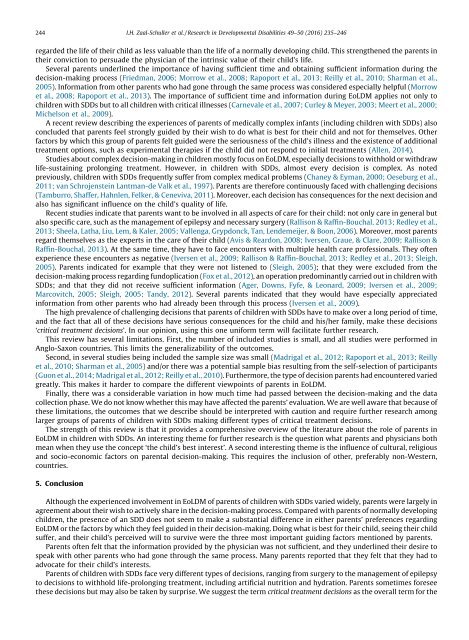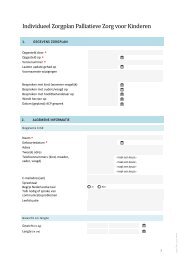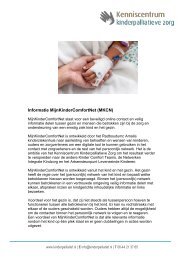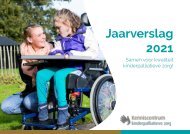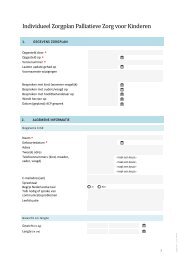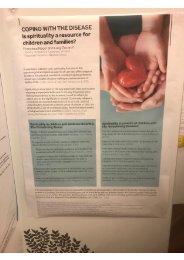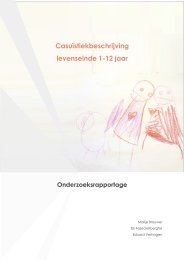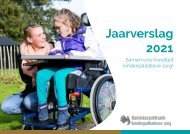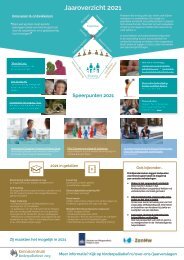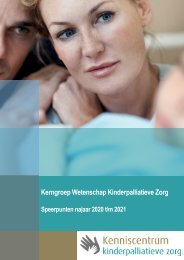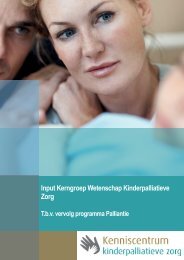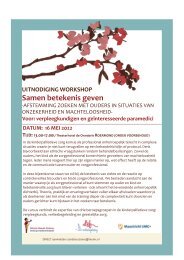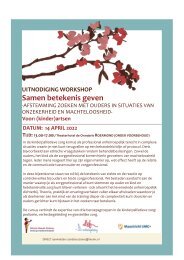End-of-life decision-making for children with severe developmental disabilities
You also want an ePaper? Increase the reach of your titles
YUMPU automatically turns print PDFs into web optimized ePapers that Google loves.
242<br />
I.H. Zaal-Schuller et al. / Research in Developmental Disabilities 49–50 (2016) 235–246<br />
One study described the preferences <strong>of</strong> parents in the <strong>decision</strong>-<strong>making</strong> process regarding a gastrostomy placement<br />
(Brotherton & Abbott, 2012) and another regarding <strong>with</strong>holding artificial nutrition and hydration (Rapoport et al., 2013). In<br />
the first study, most mothers who had been allowed to make the final <strong>decision</strong> evaluated this as very positive. Several<br />
mothers underlined that this leading role had enabled them to make a true child-centred <strong>decision</strong>. Mothers who had not had<br />
any say in the <strong>decision</strong>-<strong>making</strong> process described feelings <strong>of</strong> resentment and guilt, even if considerable time had elapsed<br />
since the gastrostomy placement (Brotherton & Abbott, 2012).<br />
In the second study, 11 bereaved parents were interviewed about their experiences regarding the <strong>decision</strong> to <strong>with</strong>hold<br />
artificial nutrition and hydration. All parents stated that this <strong>decision</strong> should only be considered when they were ready, i.e.<br />
when they viewed their child’s quality <strong>of</strong> <strong>life</strong> as very poor. Parents highly appreciated it when the option to <strong>with</strong>hold artificial<br />
nutrition and hydration was discussed <strong>with</strong> them in a sensitive, non-judgemental and supportive way. They also found it<br />
helpful when pr<strong>of</strong>essionals shared their knowledge and past experiences. Finally, parents greatly appreciated the<br />
in<strong>for</strong>mation that <strong>with</strong>holding artificial nutrition and hydration would not lead to an uncom<strong>for</strong>table dying process. All<br />
parents included in this study believed the <strong>decision</strong> was theirs alone to make (Rapoport et al., 2013).<br />
In a fourth study, parents did not clearly specify their preferred way to be involved. However, this study described the<br />
different <strong>decision</strong>-<strong>making</strong> styles parents had, <strong>with</strong> some parents relying solely on in<strong>for</strong>mation and others on values and<br />
feelings (Sharman et al., 2005).<br />
3.3. Guiding factors in parental <strong>decision</strong>-<strong>making</strong><br />
In <strong>making</strong> an EoLD <strong>for</strong> their child, parents felt guided and motivated by a combination <strong>of</strong> factors, <strong>with</strong> as most important<br />
factors: their assessment <strong>of</strong> their child’s suffering; their assessment <strong>of</strong> his or her quality <strong>of</strong> <strong>life</strong>; their wish to do what was best<br />
<strong>for</strong> their child; and their urge to advocate <strong>for</strong> their child’s interests.<br />
One study investigated whether the specific medical condition <strong>of</strong> the child, such as an SDD, was an important factor <strong>for</strong><br />
parents in the EoLDM <strong>for</strong> their child. However, parents in this study described that putting the child’s needs first, advocating<br />
<strong>for</strong> their child’s interests and focusing on their child’s quality <strong>of</strong> <strong>life</strong> were the most important factors in the <strong>decision</strong>-<strong>making</strong>,<br />
regardless <strong>of</strong> their child’s diagnosis or the presence <strong>of</strong> a chronic condition (October et al., 2014).<br />
The question by which factors parents felt guided in their EoLDM was investigated in all studies except in one (Madrigal<br />
et al., 2012). The child’s perceived poor quality <strong>of</strong> <strong>life</strong> (Rapoport et al., 2013) and doing what was best <strong>for</strong> the child<br />
(Brotherton & Abbott, 2012; Sharman et al., 2005) appeared to be the most important guiding factors in EoLDM in three<br />
studies. In defining quality <strong>of</strong> <strong>life</strong> parents concretely named the child’s ability to interact meaningfully <strong>with</strong> his/her<br />
environment and the ability to enjoy things (Rapoport et al., 2013).<br />
According to two other studies, the parents’ personal observations <strong>of</strong> their child’s suffering and pain weighed heavily in<br />
their wish to <strong>with</strong>draw <strong>life</strong>-prolonging treatment (Rapoport et al., 2013; Sharman et al., 2005). Parents also felt guided by the<br />
will they perceived in their child to survive. They based this conviction on their observations <strong>of</strong> the child’s behaviour, his or<br />
her body language and eye contact (Sharman et al., 2005). Parents <strong>of</strong> <strong>children</strong> <strong>with</strong> trisomy 13 and 18 especially weighed the<br />
child’s anomalies, such as brain and cardiac defects, in their wish to <strong>with</strong>hold <strong>life</strong>-prolonging treatment (Guon et al., 2014). In<br />
the two studies regarding the <strong>decision</strong> <strong>of</strong> a gastrostomy placement, parents reported different considerations. Extreme<br />
feeding difficulties appeared to be an important reason <strong>for</strong> the parents who agreed <strong>with</strong> this placement (Morrow et al., 2008).<br />
By contrast, the loss <strong>of</strong> everyday mothering activities was an important reason <strong>for</strong> other parents to not want a gastrostomy<br />
placement (Brotherton & Abbott, 2012). Moreover, many mothers regarded the placement <strong>of</strong> a gastrostomy as a personal<br />
failure to adequately feed their child (Brotherton & Abbott, 2012; Morrow et al., 2008). The side effects <strong>of</strong> artificial feeding,<br />
such as pain, nausea, and vomiting, contributed to the <strong>decision</strong> to <strong>with</strong>hold artificial nutrition and hydration and in all cases<br />
resulted in the child’s death (Rapoport et al., 2013).<br />
Parents <strong>of</strong>ten felt they had to advocate <strong>for</strong> their child’s interests (Guon et al., 2014; Morrow et al., 2008; October et al.,<br />
2014; Reilly et al., 2010; Sharman et al., 2005). They did this by explaining to the pr<strong>of</strong>essionals that a <strong>decision</strong> had to be based<br />
on the needs <strong>of</strong> their child at that point in time and not on the fact that their child was disabled (Morrow et al., 2008). If<br />
parents could still experience their child’s <strong>life</strong> as positive and enriching, regardless <strong>of</strong> his/her <strong>life</strong> expectancy, they strongly<br />
favoured the continuation <strong>of</strong> <strong>life</strong>-prolonging measures (Guon et al., 2014; Sharman et al., 2005).<br />
The role <strong>of</strong> religion was investigated in two studies. In both studies, parents indicated that religious beliefs had not been a<br />
guiding factor in their <strong>decision</strong>-<strong>making</strong> (Guon et al., 2014; Sharman et al., 2005). However, according to one study, several<br />
parents felt strengthened by their belief in God. This helped them to better cope <strong>with</strong> the painful <strong>decision</strong>-<strong>making</strong> process.<br />
Some <strong>of</strong> these parents also felt that only God had the final <strong>decision</strong>-<strong>making</strong> authority (Sharman et al., 2005).<br />
Additional guiding factors in EoLDM that were mentioned in various studies were: the opinion <strong>of</strong> the other parent<br />
(Rapoport et al., 2013; Reilly et al., 2010) and previous experiences <strong>with</strong> EoLDM <strong>for</strong> a loved one (Sharman et al., 2005). One<br />
mother stated that the financial burden <strong>of</strong> having to care <strong>for</strong> a <strong>severe</strong>ly disabled child had convinced her to agree to <strong>with</strong>hold<br />
<strong>life</strong>-prolonging treatment (Sharman et al., 2005).<br />
Most parents were well aware that they were highly dependent on the in<strong>for</strong>mation provided by the physicians. One study<br />
showed that the provision <strong>of</strong> written explanatory in<strong>for</strong>mation about resuscitation in a non-acute setting led to a significant<br />
increase in requests to <strong>with</strong>hold this treatment (Friedman, 2006).<br />
Five studies indicated that parents felt that the in<strong>for</strong>mation provided by the physician had been insufficient because, <strong>for</strong><br />
example, they had not been in<strong>for</strong>med about other treatment options (Friedman, 2006; Guon et al., 2014; Morrow et al., 2008;


